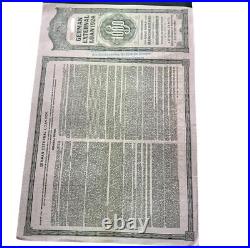



If you want a PASSCO, you can contact me so we can arrange it. You will pay for the PASSCO. About this rare and precious collectible. The Dawes Plan as proposed by the Dawes Committee, chaired by Charles G. Dawes was a plan in 1924 that successfully resolved the issue of World War I reparations that Germany had to pay. It ended a crisis in European diplomacy following World War I and the Treaty of Versailles. Because the Plan resolved a serious international crisis, Dawes shared the Nobel Peace Prize in 1925 for his work. It was an interim measure and proved unworkable. The Young Plan was adopted in 1929 to replace it. At the conclusion of World War I, the Allied and Associate Powers included in the Treaty of Versailles a plan for reparations to be paid by Germany; 20 billion gold marks was to be paid while the final figure was decided. In 1921, the London Schedule of Payments established the German reparation figure at 132 billion gold marks (separated into various classes, of which only 50 billion gold marks was required to be paid). German industrialists in the Ruhr Valley, who had lost factories in Lorraine which went back to France after the war, demanded hundreds of millions of marks compensation from the German government. Despite its obligations under the Versailles Treaty, the German government paid the Ruhr Valley industrialists, which contributed significantly to the hyperinflation that followed. For the first five years after the war, coal was scarce in Europe and France sought coal exports from Germany for its steel industry. The Germans needed coal for home heating and for domestic steel production, having lost the steel plants of Lorraine to the French. In early 1923, Germany defaulted on its reparations and German coal. Item ordered is the exact piece shown. This is an amazing piece of history to add to your collectibles.


